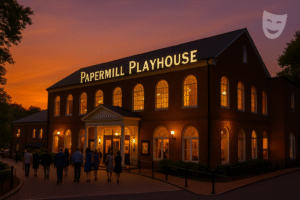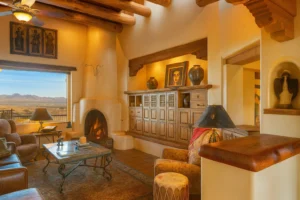Tudor house style offers more than good looks. It carries history, beauty, and bold design that speaks to homeowners across the world. These homes stand out in any neighborhood. Their mix of brick, stone, and wood gives each one a strong and graceful presence. The tall gables, narrow windows, and decorative beams show thought and care in every part of the structure.
This style began many centuries ago but still finds fans today. You can see Tudor homes across older parts of Europe and the United States. Many people admire them for their storybook charm. Others choose them because they feel warm and solid. Their unique shape and use of natural materials attract those who want something different from modern glass and steel.
A Tudor house does not follow trends. It holds its ground with strength and style. Homeowners often want to restore or copy its design. Builders use this style in new neighborhoods that seek classic appeal. Interior designers borrow its deep tones, exposed wood, and textured walls. The charm of Tudor design lasts through decades and continues to shape how people think about home beauty.
This guide explains the full picture. You will learn where the style came from and how it grew. You will see the parts that define a Tudor house, how it fits in modern homes, and ways to use the design wisely. Whether you want to buy, build, restore, or just learn more, this article gives you everything you need.
The History Behind Tudor House Style
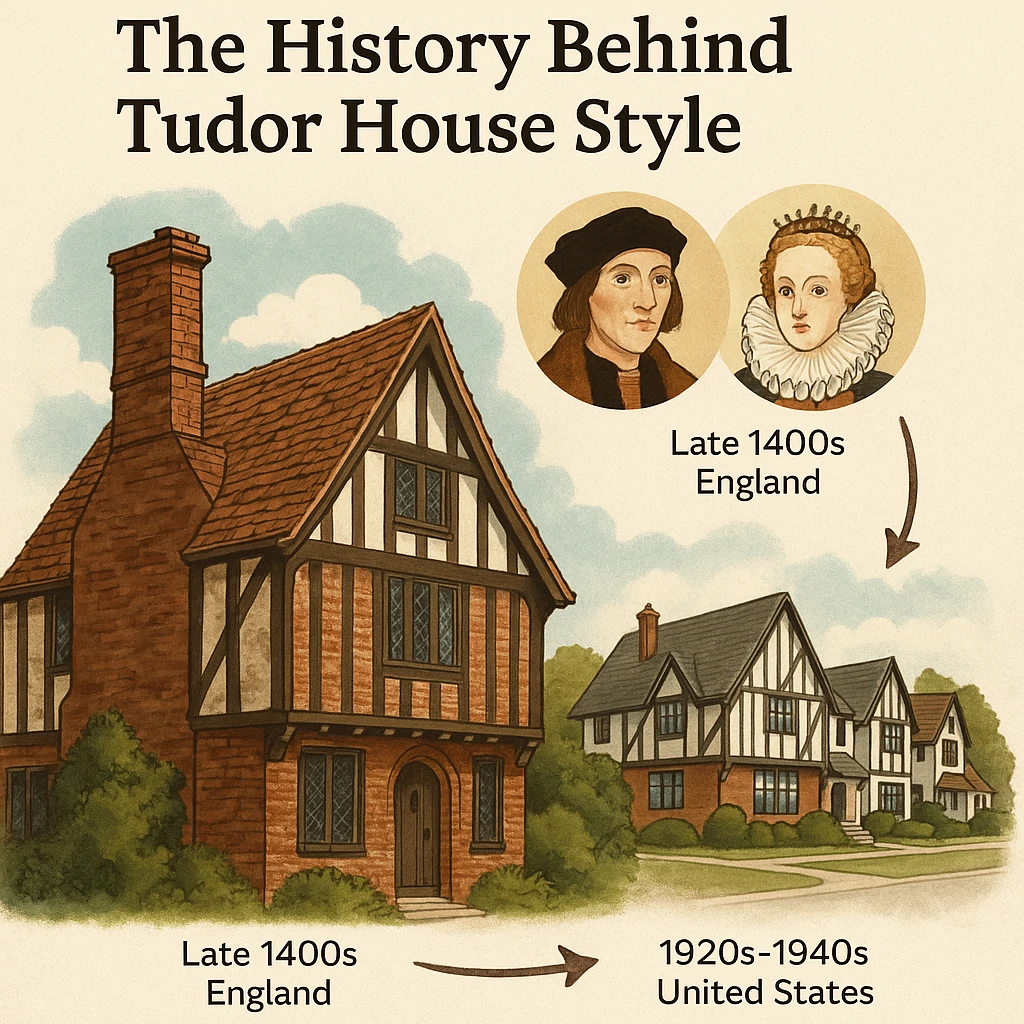
Tudor house style began in England during the late 1400s. It came at the end of the medieval period and led into the Renaissance. This was a time of change in ideas, art, and design. Homes built during this time had features that broke away from castle-like shapes. Builders used more windows, softer roofs, and better layouts for daily life.
We call this style “Tudor” because it grew during the rule of the Tudor family. It started with King Henry VII and ended with Queen Elizabeth I. During this era, England saw peace, trade, and strong building methods. Timber, stone, and brick became more available. Workers built homes with care and skill. Many features seen in old Tudor homes still appear in modern versions.
Tudor homes spread beyond England during the 19th and early 20th centuries. In the United States, people loved the look and strength of these homes. The Tudor Revival movement brought this style to American suburbs. From the 1920s through the 1940s, neighborhoods saw rows of Tudor-style homes rise from the ground. These homes showed taste, wealth, and love for European charm.
Today, the Tudor look blends with modern life. Architects design new homes that use classic elements without losing comfort. People restore older Tudors with smart updates that keep the style alive. The history of the Tudor house makes it more than a design. It stands as a living link to the past.
What Makes a Tudor House Unique

Tudor homes look different from most others. They have special features that set them apart. Each piece adds to the strong and graceful style.
Steep Pitched Roofs
One of the first things you notice is the steep roof. It points high and draws the eye upward. This shape helps rain and snow fall away fast. The roof often includes side gables, giving depth to the shape of the house.
Half-Timbered Walls
Many Tudor houses show wooden beams on the outside. These beams form patterns that cross over stucco or brick. This look comes from the way builders framed walls long ago. The beams are not just for show. They were part of the home’s structure. Modern versions copy this style to keep the same old-world feel.
Tall, Narrow Windows
Tudor windows tend to be slim and long. They often sit in groups of three or four. You may see small panes of glass held by lead strips. The windows may use wood or stone frames. Arched tops or diamond patterns add to the charm.
Massive Chimneys
Another bold feature is the large chimney. These rise high and sit at the end or middle of the home. Some chimneys include stonework, brick patterns, or chimney pots. They remind us of the time when most homes used fireplaces to stay warm.
Brick and Stone Blend
Tudor homes often use more than one material. Brick, stone, wood, and plaster all work together. The blend gives the house texture and color. You may see brick on the first floor and timber on the second. This contrast brings depth and style to the home’s face.
Arched Doorways
Doors often sit inside low arches. Heavy wooden doors with iron hinges and handles give a bold welcome. Some doors feature small windows or carvings that add to the character.
These features work together to give Tudor homes their strong and timeless look. Each part serves a role. None feels too much. The style stays balanced.
To maintain the charm and structure of a Tudor-style home, many homeowners turn to professional help. A house manager can keep daily operations smooth, ensuring the style stays intact without added stress.
Tudor Style vs Other Classic Home Styles
Many classic homes offer charm, but the Tudor style stands apart. It shows more bold lines, heavy textures, and deep tones than most.
Colonial homes use straight lines and simple shapes. They reflect balance but not drama. Victorian homes favor fancy trim and bright colors. They bring detail but not the solid warmth that Tudor offers.
Craftsman homes focus on clean woodwork and open porches. They feel relaxed and bright. Tudor homes feel rooted and bold. Their mix of wood, stone, and shadow gives depth and strength.
Each style has value. Tudor homes speak to those who want history with power. They look solid, not soft. They offer shelter and presence at the same time.
Tudor Style in American Homes
In the United States, Tudor style became popular during the 1920s and 1930s. Cities like Chicago, Boston, and Los Angeles have entire streets with these homes. Many upper-middle-class families chose them for their sturdy build and rich look.
Builders in the U.S. often used local brick and stone. Some homes kept the half-timber look. Others focused on brick with steep gables and grand chimneys. These homes kept the feel of old England while using modern layouts inside.
Inside these homes, rooms often feel cozy. Wood paneling covers walls. Ceilings may have exposed beams. Fireplaces sit at the center of living spaces. The mix of warmth and elegance gives a special charm.
Tudor homes fit well in many settings. They look right in wooded areas, hillsides, or tree-lined suburbs. Their earthy tones and shapes feel natural. People who want a home full of detail often choose this style.
Best U.S. Cities for Tudor Homes
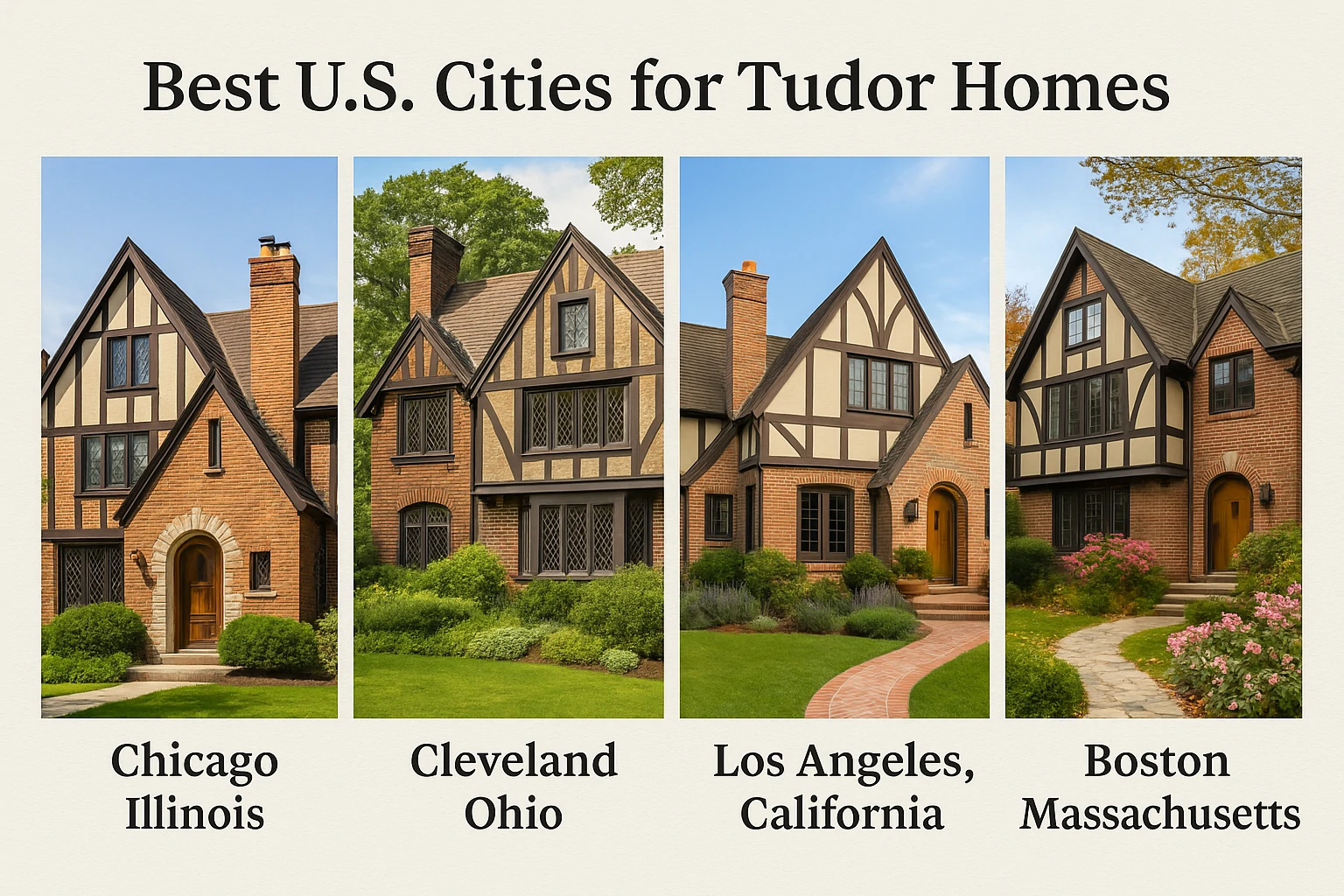
Some parts of the U.S. have more Tudor homes than others. These cities show strong love for the style and have many great examples.
Chicago, Illinois
This city has entire blocks with Tudor homes. Most were built during the 1920s housing boom. Many still stand strong with arched doors and brick chimneys.
Cleveland, Ohio
The Shaker Heights area has many Tudor Revival homes. Builders mixed American comfort with old English charm.
Los Angeles, California
Neighborhoods like Hancock Park show off luxury Tudor homes. These houses blend early Hollywood taste with lasting style.
Boston, Massachusetts
Suburbs like Brookline hold Tudor homes built in the 1930s. These homes keep their old charm and add strong value.
How to Decorate a Tudor-Style Interior
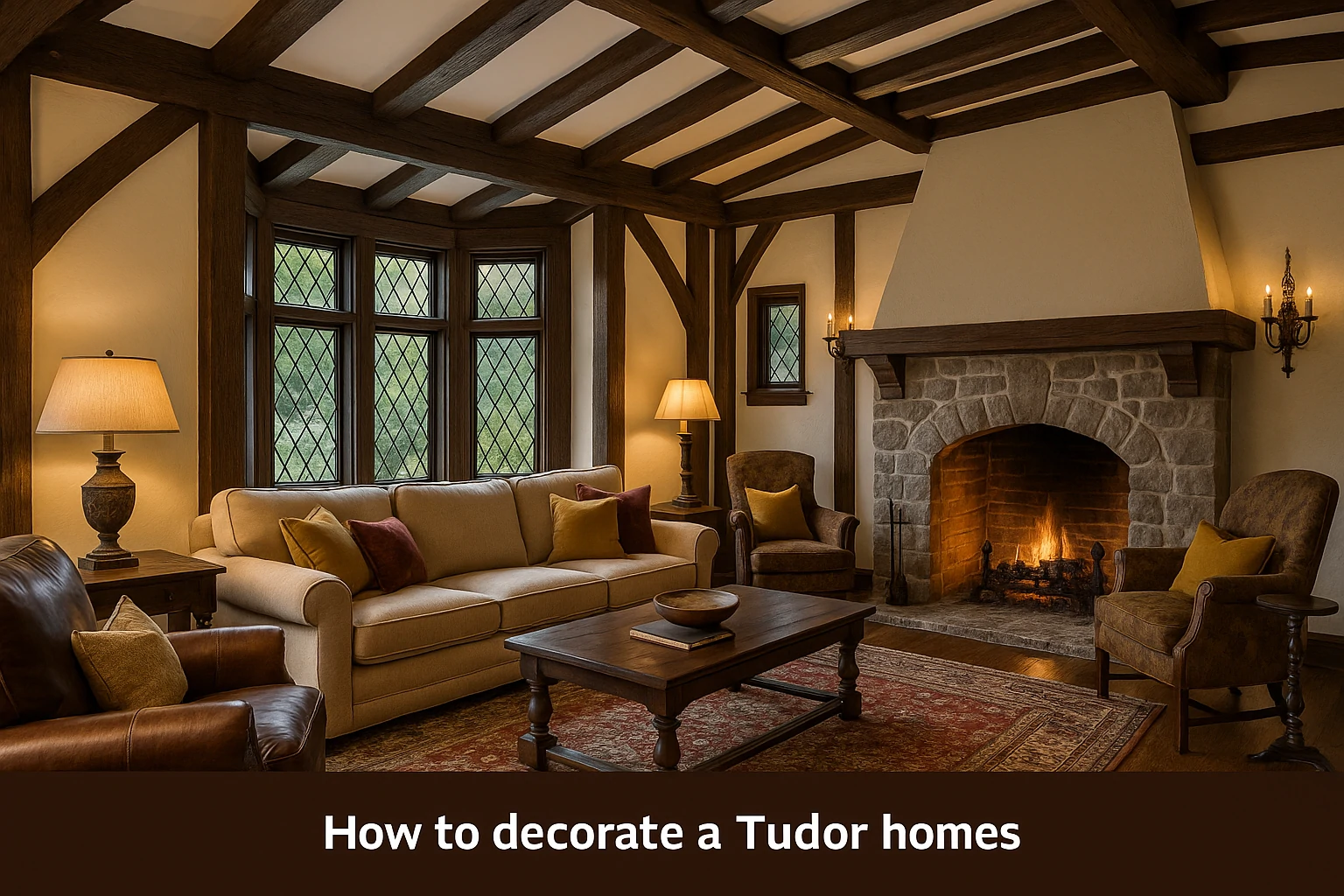
A Tudor home tells a story before anyone even steps inside. The steep rooflines, heavy beams, and tall chimneys create a strong presence. They speak of age, tradition, and lasting craft. The exterior draws you in with bold shapes and deep textures. Once inside, that promise must continue. The interior should reflect the same sense of grounded beauty. It should feel warm, solid, and timeless.
Decorating a Tudor-style interior does not mean copying history room for room. It means respecting the structure, using honest materials, and making choices that feel right for the space. The goal is not to chase trends or create contrast. The goal is to create balance-to let old-world charm meet modern comfort without tension.
A true Tudor interior feels rich without being heavy. It uses texture and shape to build mood. Every beam, every stone, every fabric should earn its place. The space should feel collected, not staged. The colors, furniture, and accents must work together to create a home that feels rooted in something greater than design.
This section offers a clear path to bring that vision to life. It starts with the materials that shape the space and moves into the color, form, and light that give the room its soul. With care and the right choices, anyone can shape a Tudor-style interior that looks and feels like it belongs-now and always.
Is a Tudor House Right for You?
| Factor | Details |
|---|---|
| Pros | • Timeless beauty with bold design • Strong curb appeal that adds value • Durable structure with solid insulation • Unique character not found in modern builds • Cozy, warm, and rich atmosphere |
| Cons | • Regular upkeep may be needed • Mixed materials can raise repair costs • Original layouts may have small kitchens and bathrooms • Restoring or remodeling may require extra care and budget |
| Best Fit | • Ideal for those who love historical charm • Good for homeowners who appreciate craftsmanship and texture • Great for people who enjoy cozy spaces and deep colors • Less suited to fans of minimal or open-concept layouts |
How to Maintain a Tudor Home the Smart Way
Tudor homes need care. Their mix of wood, brick, and stone brings beauty but also risk if ignored.
Watch the Wood
Check beams and trim each year. Moisture can lead to rot. A coat of sealant or paint keeps water out and color rich.
Care for the Roof
Steep roofs need strong shingles and clean gutters. Replace cracked tiles and check flashing near chimneys.
Protect the Windows
Leaded glass needs soft cleaning. Replace broken panes with care. Keep frames sealed so cold and bugs stay out.
Brick and Mortar
Old bricks may chip. Tuckpointing fixes gaps in mortar. This keeps walls solid and stops water from leaking in.
Tudor homes last long when maintained. A little care goes a long way in keeping their bold look alive.
Tudor homes reflect a deep connection to England’s architectural past. If you enjoy this regal charm, you may also like the detailed look inside Spencer House in London, a landmark rich in royal tradition and design influence.
How to Add Tudor Features to a Modern Home
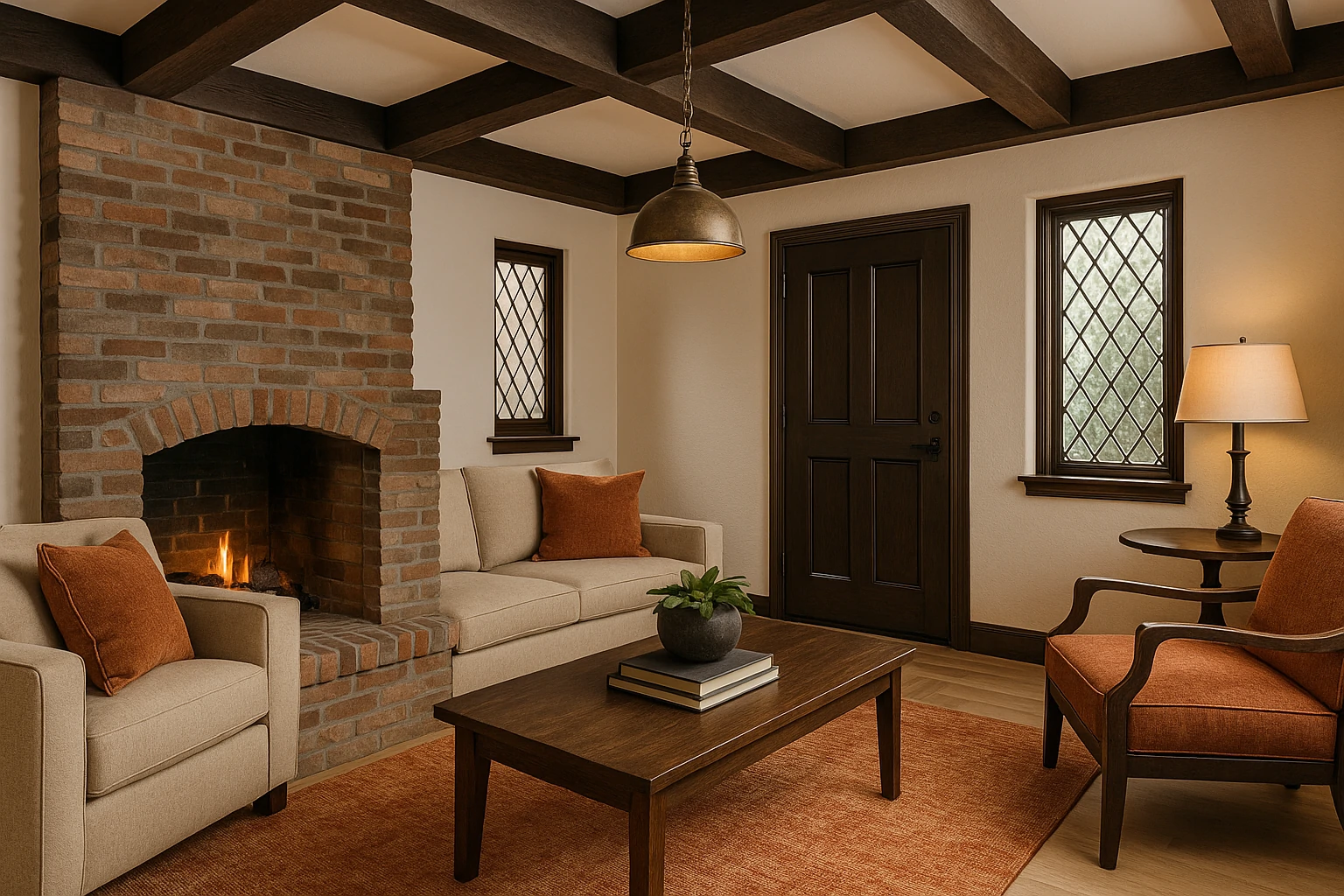
You do not need a full Tudor house to enjoy the style. You can add pieces of it to your current home.
- Add fake timber beams to ceilings or walls.
- Use brick or stone around your fireplace.
- Pick dark wood doors and trim.
- Install leaded glass in small windows.
- Use Tudor colors in paint and fabrics.
- Choose vintage lighting with iron or brass.
These changes work well in older homes or new ones that aim for classic charm.
Landscaping Ideas That Match Tudor Homes
Your yard should reflect the house. Tudor homes look best with calm, classic gardens that follow their strong lines.
Use stone paths that lead to the arched doorway. Add ivy or roses near the entry to soften the wood and brick. Choose evergreen shrubs for shape and color year-round.
Keep lawns trimmed, but do not make them flat. Raised beds or a small hedge give texture. Lantern-style lights and wooden gates finish the look.
A Tudor yard should feel hidden yet warm. It should hint at old stories without feeling like a movie set. Small touches matter more than big ones.
What to Avoid in Tudor Style Renovations
Some updates break the Tudor charm. They remove the soul of the house.
Do not install bright vinyl siding or modern glass doors. These fight with the home’s deep tones. Avoid flat roofs or open-plan layouts that remove cozy spaces. Do not use shiny steel or plastic near the entry.
Stick with natural textures-stone, wood, and iron. Keep dark trim and textured walls. Choose updates that match the old bones of the home.
Smart updates add comfort. But careless changes break the magic. Let the house stay true to its roots.
Final Thoughts
Tudor house style stands the test of time. Its roots go deep, and its charm remains strong. From grand rooftops to cozy fireplaces, each part tells a story. You see not just a home, but a piece of history built with skill and care.
This guide has shown you where the style came from and what makes it special. You now know how to spot a Tudor, how to live in one, and how to bring its beauty into your own space. Whether you own a Tudor home, want to buy one, or simply love the look, this style invites you in with warmth and strength.
A Tudor house does not just shelter. It speaks, stands, and stays. It reminds us that good design lasts. In a world that moves fast, Tudor homes remain still and proud. They offer more than comfort. They give a sense of place and peace.
Some wealthy homeowners blend Tudor charm with modern luxury. If you enjoy peeking inside elite homes, take a tour of Jerry Jones’s Texas mansion for bold design inspiration.



